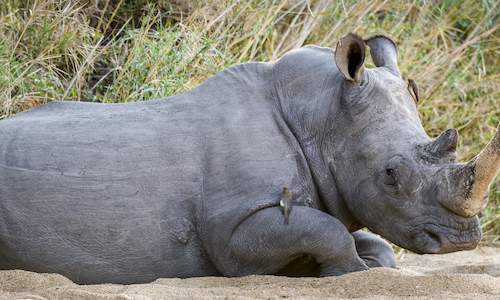
Two researchers representing the San Diego Zoo's Conservation and Research for Endangered Species (CRES) centre are currently travelling throughout South Africa conducting a study that hopes to unravel the mystery of why zoo populations of rhinos across the world are not reproducing as expected.
Across northern America and Europe, zoos are finding that female white rhinos born in captivity are not breeding as expected, with the result that the number of rhinos in captivity may soon dramatically dwindle as wild-caught adults pass reproductive age and subsequently die, with no new babies to replace them.
The problem of the captive-born females not breeding has been puzzling zoological institutions for some time. After comparing the results of years of behavioural and reproductive studies in zoos and the Hluhluwe-Umfolozi Park in KwaZulu-Natal, it was decided that a new study was needed to try and shed some more light on the problem.
This led to Shannon Chapman from San Diego and Dale Airton from KwaZulu-Natal joining forces to travel to all the areas in South Africa where rhinos are kept on game ranches less than 10,000ha in size, and preferably less than 2,000ha.
Currently four months into their six-month survey, which will be followed by six months of data analysis, they visit all willing game farmers and fill our questionnaires and conduct interviews with anyone who has kept rhinos on game farms of the required size. According to Shannon, they are finding that South African ranches are not having the same problems as the zoos, and that second generation 'captive' female rhinos are successfully breeding on the game farms, even the smaller ones.
One of the theories proposed by Dr Ron Swaisgood from San Diego's CRES centre is that the female rhinos in zoos are being bred too young, at two and half to three years old, as opposed to wild rhinos which breed at around five. The early breeding may be leading to uterine infections in the young rhino, which damage their reproductive organs so that they cannot have calves in later life.
They have also found that male rhinos in captivity tend to follow certain females and harass them, whereas in the wild with larger territories male rhinos are not able to do this as much Although Shannon and Dale's research is supporting the theory that wild rhinos breed later than the rhinos in zoos, no one is sure yet why this is happening, and why wild male rhinos are more inclined to ignore young females than they are in zoos.
Using data gathered on the questionnaire, which looks for information on social, nutritional, ecological and reproductive histories on rhinos on small reserves, they hope to be able to test various theories. After all the analysis is performed, the plan is to create new management strategies for zoos and animal parks that will hopefully increase breeding success in captive rhino, ensuring a future zoo population of rhinos without more having to be taken from the wild.
Dale and Shannon are encouraging anyone who has a suitably sized property, preferably on the smaller end of the scale, to contact them so that they can get the most information possible about rhino breeding on small reserves in South Africa. Dale and Shannon can be reached on 084 240 6276.

 Rhino Conservation in Kruger National Park is an extremely important part of protecting one of the most endangered species in the world. The...
Rhino Conservation in Kruger National Park is an extremely important part of protecting one of the most endangered species in the world. The...